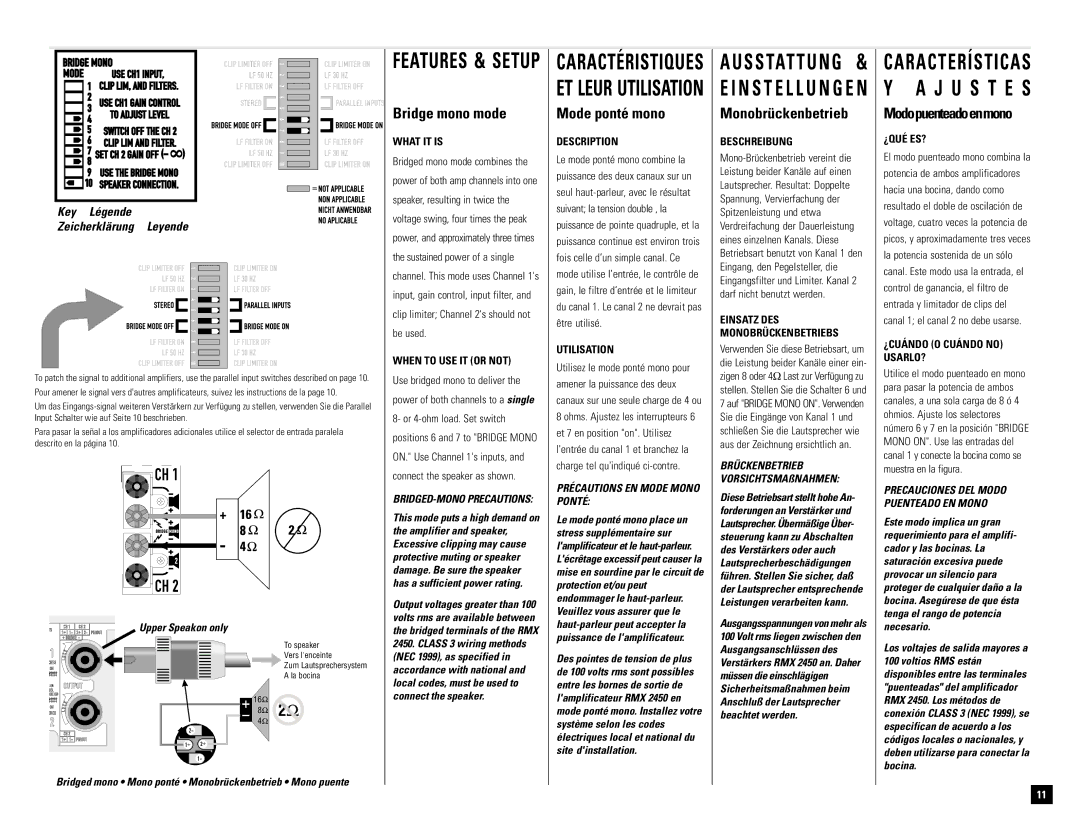Key Légende
Zeicherklärung Leyende
To patch the signal to additional amplifiers, use the parallel input switches described on page 10.
Pour amener le signal vers d'autres amplificateurs, suivez les instructions de la page 10.
Um das Eingangs-signal weiteren Verstärkern zur Verfügung zu stellen, verwenden Sie die Parallel Input Schalter wie auf Seite 10 beschrieben.
Para pasar la señal a los amplificadores adicionales utilice el selector de entrada paralela descrito en la página 10.
FEATURES & SETUP
Bridge mono mode
WHAT IT IS
Bridged mono mode combines the power of both amp channels into one speaker, resulting in twice the voltage swing, four times the peak power, and approximately three times the sustained power of a single channel. This mode uses Channel 1's input, gain control, input filter, and clip limiter; Channel 2's should not be used.
WHEN TO USE IT (OR NOT)
Use bridged mono to deliver the power of both channels to a single 8- or 4-ohm load. Set switch positions 6 and 7 to "BRIDGE MONO ON." Use Channel 1's inputs, and connect the speaker as shown.
BRIDGED-MONO PRECAUTIONS:
This mode puts a high demand on the amplifier and speaker, Excessive clipping may cause protective muting or speaker damage. Be sure the speaker has a sufficient power rating.
CARACTÉRISTIQUES ET LEUR UTILISATION
Mode ponté mono
DESCRIPTION
Le mode ponté mono combine la puissance des deux canaux sur un seul haut-parleur, avec le résultat suivant; la tension double , la puissance de pointe quadruple, et la puissance continue est environ trois fois celle d’un simple canal. Ce mode utilise l’entrée, le contrôle de gain, le filtre d’entrée et le limiteur du canal 1. Le canal 2 ne devrait pas être utilisé.
UTILISATION
Utilisez le mode ponté mono pour amener la puissance des deux canaux sur une seule charge de 4 ou 8 ohms. Ajustez les interrupteurs 6 et 7 en position "on". Utilisez l'entrée du canal 1 et branchez la charge tel qu'indiqué ci-contre.
PRÉCAUTIONS EN MODE MONO PONTÉ:
Le mode ponté mono place un stress supplémentaire sur l'amplificateur et le haut-parleur. L'écrêtage excessif peut causer la mise en sourdine par le circuit de protection et/ou peut endommager le haut-parleur.
AUSSTATTUNG & E I N S T E L L U N G E N
Monobrückenbetrieb
BESCHREIBUNG
Mono-Brückenbetrieb vereint die Leistung beider Kanäle auf einen Lautsprecher. Resultat: Doppelte Spannung, Vervierfachung der Spitzenleistung und etwa Verdreifachung der Dauerleistung eines einzelnen Kanals. Diese Betriebsart benutzt von Kanal 1 den Eingang, den Pegelsteller, die Eingangsfilter und Limiter. Kanal 2 darf nicht benutzt werden.
EINSATZ DES
MONOBRÜCKENBETRIEBS
Verwenden Sie diese Betriebsart, um die Leistung beider Kanäle einer ein- zigen 8 oder 4WLast zur Verfügung zu stellen. Stellen Sie die Schalter 6 und 7 auf "BRIDGE MONO ON". Verwenden Sie die Eingänge von Kanal 1 und schließen Sie die Lautsprecher wie aus der Zeichnung ersichtlich an.
BRÜCKENBETRIEB VORSICHTSMAßNAHMEN:
Diese Betriebsart stellt hohe An- forderungen an Verstärker und Lautsprecher. Übermäßige Über- steuerung kann zu Abschalten des Verstärkers oder auch Lautsprecherbeschädigungen führen. Stellen Sie sicher, daß der Lautsprecher entsprechende
CARACTERÍSTICAS Y A J U S T E S
Modopuenteadoenmono
¿QUÉ ES?
El modo puenteado mono combina la potencia de ambos amplificadores hacia una bocina, dando como resultado el doble de oscilación de voltage, cuatro veces la potencia de picos, y aproximadamente tres veces la potencia sostenida de un sólo canal. Este modo usa la entrada, el control de ganancia, el filtro de entrada y limitador de clips del canal 1; el canal 2 no debe usarse.
¿CUÁNDO (O CUÁNDO NO) USARLO?
Utilice el modo puenteado en mono para pasar la potencia de ambos canales, a una sola carga de 8 ó 4 ohmios. Ajuste los selectores número 6 y 7 en la posición "BRIDGE MONO ON". Use las entradas del canal 1 y conecte la bocina como se muestra en la figura.
PRECAUCIONES DEL MODO PUENTEADO EN MONO
Este modo implica un gran requerimiento para el amplifi- cador y las bocinas. La saturación excesiva puede provocar un silencio para proteger de cualquier daño a la
UTS
1
ITCHES
IT ON
S IN LEL ODE ON
IT ON
ITCHES
2
1+ 1- 2+ 2- PINOUT BRIDGE -
K
C
O
L
OUTPUT
K
C
O
L
CH 2
1+ 1- PINOUT
Upper Speakon only
To speaker
Vers l'enceinte
Zum Lautsprechersystem
A la bocina
Output voltages greater than 100 volts rms are available between the bridged terminals of the RMX 2450. CLASS 3 wiring methods (NEC 1999), as specified in accordance with national and local codes, must be used to connect the speaker.
Veuillez vous assurer que le haut-parleur peut accepter la puissance de l'amplificateur.
Des pointes de tension de plus de 100 volts rms sont possibles entre les bornes de sortie de l'amplificateur RMX 2450 en mode ponté mono. Installez votre système selon les codes électriques local et national du site d'installation.
Leistungen verarbeiten kann.
Ausgangsspannungen von mehr als 100 Volt rms liegen zwischen den Ausgangsanschlüssen des Verstärkers RMX 2450 an. Daher müssen die einschlägigen Sicherheitsmaßnahmen beim Anschluß der Lautsprecher beachtet werden.
bocina. Asegúrese de que ésta tenga el rango de potencia necesario.
Los voltajes de salida mayores a 100 voltios RMS están disponibles entre las terminales "puenteadas" del amplificador RMX 2450. Los métodos de conexión CLASS 3 (NEC 1999), se especifican de acuerdo a los códigos locales o nacionales, y deben utilizarse para conectar la bocina.

